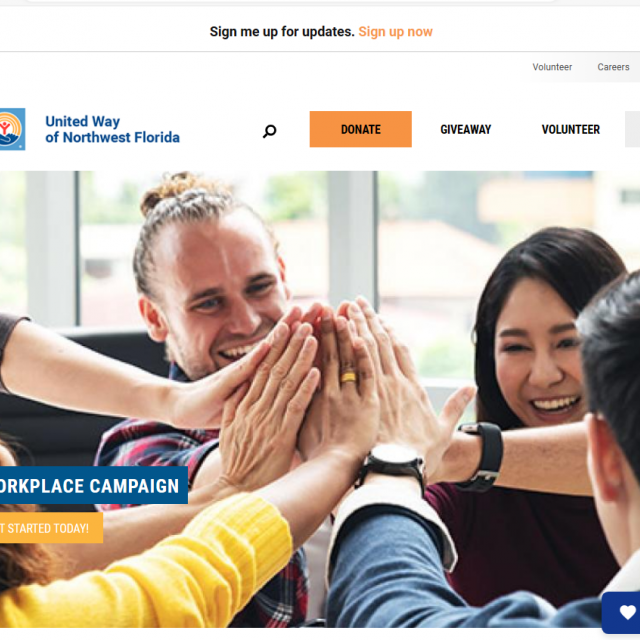
Why would you need a comprehensive website evaluation checklist for your nonprofit? Well, your nonprofit website serves as a digital gateway to your organization, connecting you with supporters, volunteers, and donors. It's not just a virtual brochure or billboard but a dynamic platform that can help you make a significant impact. To ensure your website is fulfilling its potential, it's vital to periodically evaluate its performance and effectiveness. In this blog post, we present a comprehensive checklist to guide you through this evaluation process.
Please note: The websites referenced in this post are included solely as examples of effective uses of features on nonprofit websites. Their inclusion does not constitute an endorsement or promotion of any of the organizations, campaigns, products, services, or viewpoints presented on those external sites.
Website Design and User Experience
Responsive Design:
Ensure your website is mobile-friendly, responsive to various screen sizes, and compatible with all devices. This ensures that visitors have a seamless experience, regardless of how they access your site.
For example, consider Save the Whales, a nonprofit dedicated to marine conservation. Their website is accessible on mobile devices, allowing visitors to easily participate in programs and fundraising campaigns while on the go. The responsive design ensures that the website layout adjusts seamlessly to different screen sizes.
Navigation:
Check the navigation of your website. Is it intuitive? Can visitors easily find the information they seek? Complex and cluttered menus can deter users from exploring your site.
For example, Education for All offers educational opportunities to underprivileged children. Their website has a clear, intuitive menu structure that allows visitors to easily navigate to different programs, success stories, and donation options.
Page Load Speed:
Assess your website's loading speed. Slow loading times can drive away visitors. Tools like Google's PageSpeed Insights can help identify areas for improvement.
For example, Feeding America, a hunger relief nonprofit, optimized its website to load quickly. As a result, visitors can quickly access information on food programs, volunteer opportunities, and donation options without experiencing frustrating delays.
Readability and Font:
Make sure your website uses readable fonts and text sizes. Content should be well-organized, making it easy for visitors to absorb the information.
For example, Doctors Without Borders uses a clean and easy-to-read font, ensuring that information about their humanitarian missions and emergency medical care is accessible to all visitors.
Visual Appeal:
Your website should be visually appealing, with a professional and cohesive design. Aesthetics can influence first impressions and engagement.
For example, the National Parks Conservation Association has a visually engaging website with stunning images of national parks. The site's design not only captivates visitors but also highlights the beauty of the parks they aim to protect.
Images and Multimedia:
Optimize images and multimedia elements for fast loading. Visual content should enhance your message without causing slow load times.
For example, the World Wildlife Fund uses high-quality images and videos of endangered species and ecosystems. These visuals not only educate visitors about their mission but also load quickly, preventing slow page load times.
Content Quality and Relevance
Mission and Impact:
Your nonprofit's mission should be clear and prominently displayed on the website. Visitors should understand your organization's purpose from the moment they land on your site.
For example, Oxfam displays its mission prominently on its homepage, ensuring that visitors understand the organization's commitment to ending poverty and social injustice.
Fresh and Updated Content:
Regularly update your website to reflect the latest news, events, and achievements. Outdated content can give the impression of a stagnant organization.
For example, the American Red Cross regularly updates its website with information about ongoing disaster relief efforts, blood donation campaigns, and volunteer stories, keeping its content fresh and relevant.
Engaging Content:
Ensure your content is engaging and compelling. It should encourage visitors to explore further, learn more, and take action.
For example, charity: water effectively engages visitors through immersive stories about clean water projects worldwide, encouraging users to explore the organization's work and donate.
Call-to-Action (CTA):
Implement clear and effective calls to action to guide visitors toward desired actions, such as donating, volunteering, or signing up for your newsletter.
For example, Habitat for Humanity prominently displays "Donate Now" and "Volunteer" CTAs throughout its website, guiding visitors to take immediate action to support their mission.
Storytelling:
Effectively tell your organization's story and connect emotionally with your audience. Share success stories and impact to illustrate the difference your nonprofit makes.
For example, The Nature Conservancy uses compelling storytelling to describe their global efforts in conservation. They share success stories and the human impact on the environment, connecting emotionally with their audience.
Functionality and Interactivity
Contact Information:
Make your contact information easily accessible for inquiries, support, and general communication.
For example, UNICEF provides clear contact information for inquiries, feedback, and support, ensuring that visitors can easily reach out with questions or concerns.
Donation and Fundraising Tools:
Ensure that donation and fundraising features are user-friendly and secure. Streamlined donation processes can increase your fundraising success.
For example, St. Jude Children's Research Hospital streamlines the donation process with a user-friendly interface, allowing supporters to contribute easily to their mission of treating and curing childhood cancer.
Forms:
Check if online forms, such as volunteer sign-up forms or contact forms, are easy to use and functional.
For example, the Humane Society offers a user-friendly adoption form for potential pet owners. This simplifies the application process, increasing the chances of finding loving homes for animals.
Search Functionality:
Offer a search feature to help visitors find specific information quickly.
For example, Amnesty International incorporates a search feature, allowing visitors to quickly locate specific reports, articles, or human rights cases on their extensive website.
Social Media Integration:
Integrate social media effectively to expand your reach and engage with your audience on multiple platforms.
For example, Greenpeace effectively integrates social media platforms, enabling visitors to share campaigns, petitions, and articles with their networks and expanding their reach.
Accessibility and Inclusivity
Accessibility Compliance:
Ensure that your website is designed to be accessible to individuals with disabilities. Compliance with accessibility regulations is vital for inclusivity.
For example, the National Federation of the Blind ensures that its website is fully accessible to individuals with visual impairments, complying with the Web Content Accessibility Guidelines (WCAG) for inclusivity.
Performance and Security
Website Speed:
Ensure your website is optimized for performance, and that web pages load quickly. Slow-loading pages can deter visitors.
For example, the World Food Programme prioritizes fast loading times for its website, ensuring that visitors can access information about global hunger relief quickly.
Website Security:
Ensure that your website is protected against common security threats. Regular updates are crucial to maintaining security.
For example, the American Cancer Society prioritizes security by protecting donor information, using SSL encryption, and maintaining up-to-date security measures to ensure the privacy of sensitive data.
Analytics and Tracking
Google Analytics:
Use web analytics tools like Google Analytics to monitor website traffic and user behavior. This data can help you make data-driven decisions.
For example, the Sierra Club uses Google Analytics to monitor website traffic, user behavior, and conversion rates. This data informs their strategies to engage supporters and increase membership.
Conversion Tracking:
Implement conversion tracking to monitor the success of various calls-to-action and goals on your website.
For example, Doctors Without Borders tracks the conversion rate of visitors signing up for their newsletter, volunteering, and making donations, allowing them to refine their online engagement strategy.
Search Engine Optimization (SEO)
Keywords:
Integrate relevant keywords into your content to improve search engine visibility.
For example, the ASPCA incorporates relevant keywords, such as "animal welfare" and "pet adoption," into their content, improving their visibility in search engine results.
Meta Tags:
Optimize meta titles and descriptions to improve search engine rankings and user click-through rates.
For example, the Red Cross optimizes meta titles and descriptions to maximize click-through rates, ensuring that users are drawn to their site when searching for disaster relief and humanitarian aid.
Sitemap:
Include a sitemap to aid search engine indexing and improve website discoverability.
For example, the United Way uses a sitemap to assist search engine crawlers in indexing their comprehensive website, making it easier for users to find information about local services and support.
Compliance and Legal
Privacy Policy:
Ensure that your website includes a clearly stated and accessible privacy policy in compliance with relevant data protection regulations.
For example, the Electronic Frontier Foundation maintains a clear and accessible privacy policy to comply with data protection regulations, ensuring that user data is handled ethically.
Copyright:
Verify that all images and content on your website are properly attributed and in compliance with copyright laws.
For example, the Museum of Modern Art ensures that all images and content on its website are properly attributed, respecting copyright laws for artwork and exhibitions.
Compatibility
Browser Compatibility:
Confirm that your website functions correctly on major web browsers such as Chrome, Firefox, Safari, and Edge.
For example, the NAACP tests its website on various browsers, ensuring that it functions seamlessly on Chrome, Firefox, Safari, and Edge, providing a consistent experience for all users.
Device Compatibility:
Ensure that your website works well on various devices, including desktops, laptops, tablets, and smartphones.
For example, the United Nations Refugee Agency ensures that its website is accessible on desktops, laptops, tablets, and smartphones, allowing users to access critical information on any device.
Performance and Loading Speed
Website Performance:
Keep your website optimized for speed, as fast load times are critical for user satisfaction.
For example, the World Wildlife Fund focuses on website optimization to maintain fast load times, allowing visitors to explore their mission, donate, and engage with wildlife conservation efforts without delay.
Monitoring and Support
Regular Maintenance:
Establish a schedule for regular maintenance and updates to keep your website running smoothly.
For example, the American Heart Association follows a schedule for regular maintenance, including updates and content refreshes, to keep their website running smoothly.
Support Contacts:
Provide clear support and maintenance contact details so that users can reach out for assistance if needed.
For example, World Vision provides a prominent "Contact Us" link in the footer. There you can easily find various contact options such as addresses, phone numbers, and to report a concern.
Backups:
Implement regular backups of your website data and content to safeguard against data loss.
For example, the United Nations Children's Fund performs regular backups of their website data and content to protect against data loss and security breaches.
By thoroughly evaluating your nonprofit's website, you can identify areas for improvement and ensure that your online presence effectively supports your organization's mission and goals. A well-maintained and user-friendly website can make a significant difference in your nonprofit's ability to connect with supporters, donors, and volunteers.
Get Your Comprehensive Website Evaluation Checklist For Nonprofits
Are you ready to evaluate your nonprofit website's performance and effectiveness to see if it's fulfilling its potential? We've created a comprehensive checklist for you in the form of an eBook that is completely free, and we want to share it with you.
To get your hands on this invaluable resource, sign up and we'll send you a download link right away. Don't worry; we respect your privacy and won't spam your inbox. We're here to support your nonprofit's journey to making a lasting impact.






